Overview
Surface Enhanced Raman Spectroscopy (SERS) serves as a pivotal tool in advancing several scientific domains, including:
- Remote patient monitoring
- Food safety
- Environmental analysis
- Pharmaceutical development
- Cancer diagnostics
- Biosensing innovations
By harnessing SERS's unique capability to enhance signal detection at low concentrations, these applications yield significant benefits. These advantages encompass:
- Improved diagnostic accuracy
- Rapid identification of contaminants
- Enhanced analysis of drug formulations
The transformative impact of SERS across these diverse fields underscores its critical role in modern scientific research and application.
Introduction
In an era where precision and speed are paramount in healthcare, environmental monitoring, and food safety, Surface Enhanced Raman Spectroscopy (SERS) stands out as a groundbreaking technology reshaping these fields. By amplifying molecular signals, SERS facilitates the detection of minute quantities of substances, thereby enabling early diagnosis in clinical settings, ensuring food safety, and monitoring environmental pollutants with remarkable accuracy.
As the demand for innovative solutions escalates, the integration of SERS with advancements in nanotechnology and machine learning is poised to revolutionize data analysis and biosensing applications. This article explores the transformative impact of SERS across various domains, underscoring its potential to enhance patient outcomes, safeguard public health, and drive scientific progress.
JM Science Electronic Stethoscope: Revolutionizing Remote Patient Monitoring with SERS
The JM Science electronic stethoscope revolutionizes remote patient monitoring through the application of surface enhanced raman spectroscopy techniques. By amplifying acoustic signals from heart and lung sounds, this advanced device empowers healthcare professionals to conduct auscultations from a distance, ensuring timely and precise assessments. The integration of surface enhanced raman spectroscopy markedly enhances sound clarity, facilitating the identification of irregularities that may signal underlying health issues. This innovation not only elevates patient care but also aligns with the increasing reliance on telemedicine, where remote diagnostics are essential, and recent advancements in surface enhanced raman spectroscopy (SERS) methods have yielded promising results in enhancing telemedicine capabilities.
Notably, during the peak of the COVID-19 pandemic, 43% of physicians reported conducting more than half of their patient consultations via remote health tools, underscoring the growing importance of such resources in modern healthcare. Furthermore, the global remote patient observation market is projected to expand at a compound annual growth rate of approximately 20% from 2023 to 2028. This growth underscores the rising demand for efficient remote diagnostic instruments, particularly those utilizing cutting-edge innovations.
Case studies indicate that organizations employing electronic stethoscopes equipped with advanced features have experienced improved patient satisfaction and outcomes. For instance, the University of Pittsburgh Medical Center reported an increase in patient satisfaction ratings exceeding 90% following the implementation of remote supervision solutions, illustrating the effectiveness of such innovations in enhancing healthcare services. This evidence highlights the positive impact of distance observation on patient experiences and outcomes.
As this system continues to evolve, its impact on telemedicine and remote diagnostics is expected to expand, offering significant benefits for both healthcare providers and patients. Insights from recent market research indicate that the adoption of this technology will likely play a crucial role in shaping the future of remote patient observation, making it an essential consideration for pharmaceutical lab managers.
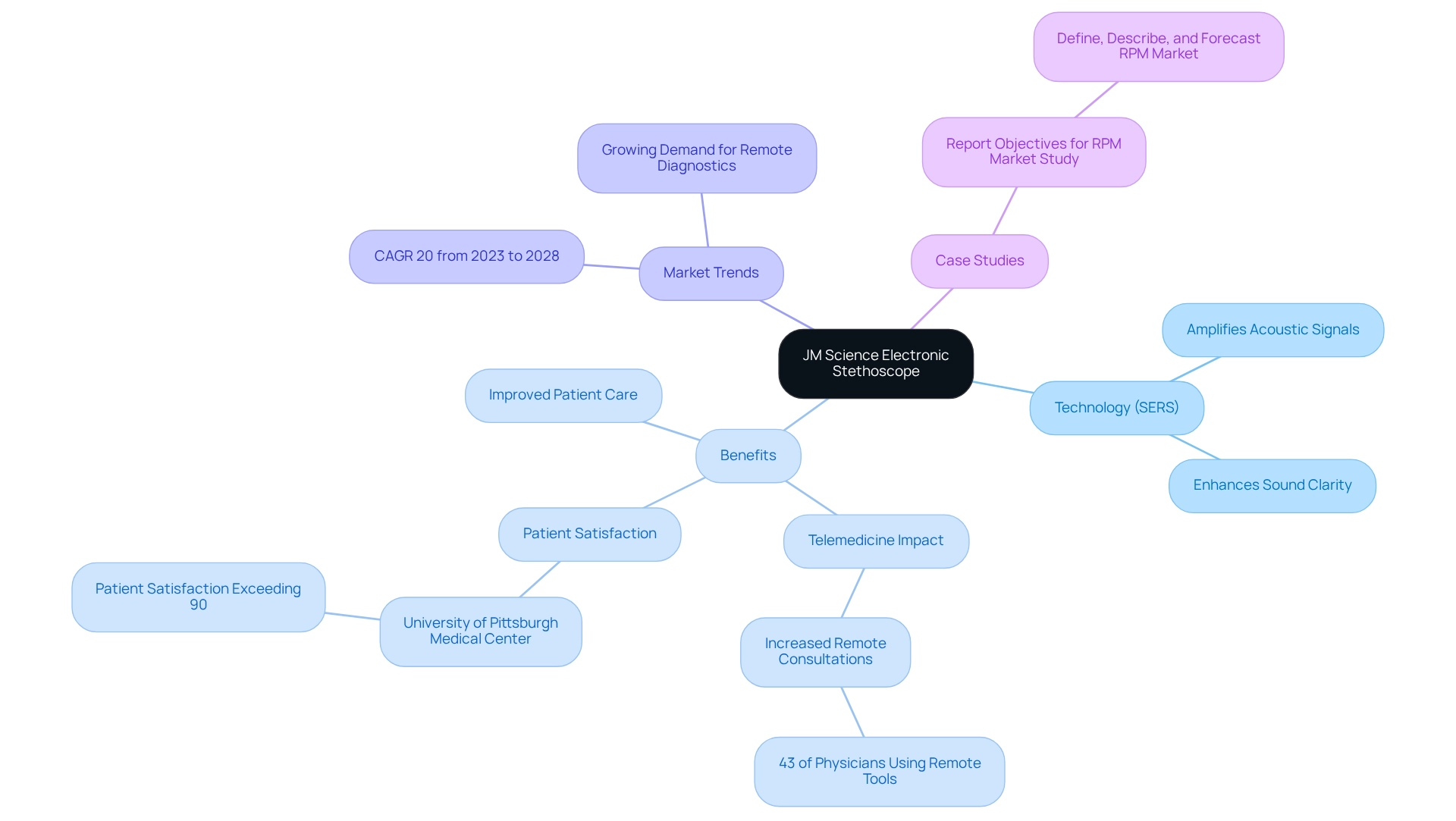
Food Safety Monitoring: Utilizing Surface Enhanced Raman Spectroscopy for Contaminant Detection
Surface enhanced raman spectroscopy is revolutionizing food safety monitoring by enabling the identification of contaminants at remarkably low levels. This cutting-edge technique excels at detecting harmful substances, such as pesticides, heavy metals, and pathogens, in food products with both speed and precision. Its ability to deliver rapid results empowers food safety inspectors to ensure compliance with safety standards, thereby safeguarding public health.
Recent advancements in surface enhanced Raman spectroscopy methodologies and substrate engineering—particularly the recognition that the size and shape of nanostructures significantly influence their surface enhanced Raman spectroscopy activity—are enhancing its effectiveness, especially in food safety applications where timely identification is critical for preventing foodborne illnesses.
The advent of portable surface enhanced Raman spectroscopy instruments is particularly noteworthy, facilitating on-site analysis of trace contaminants and streamlining the identification process. This innovation allows for immediate interventions, significantly mitigating the risks associated with contaminated food products.
A case study on portable surface enhanced raman spectroscopy applications illustrates how this technology simplifies the detection process, making on-site analysis of trace contaminants not only feasible but also efficient.
As the landscape of food safety monitoring evolves, understanding and addressing matrix effects will be vital for achieving reproducible results in surface enhanced raman spectroscopy analysis. This understanding is crucial, as matrix effects can significantly impact result precision, underscoring the necessity for thorough evaluation in surface enhanced raman spectroscopy applications.
By 2025, the integration of surface enhanced raman spectroscopy into food safety inspections is becoming increasingly prevalent, with successful implementations demonstrating its reliability and efficacy. Expert opinions underscore the importance of surface enhanced raman spectroscopy in improving food safety protocols, emphasizing its role in the ongoing battle against food contamination.
As Moskovits noted, the concept of plasmon excitation connects surface-enhanced Raman scattering to the excitation of surface plasmons in nanostructured metals, providing a deeper understanding of the scientific principles that underpin this technology.
As the demand for efficient assessment methods escalates, this technology emerges as a critical resource for food safety experts, ensuring that food items are safe for consumption.

Environmental Analysis: Surface Enhanced Raman Spectroscopy for Pollutant Detection
Surface enhanced raman spectroscopy has established itself as a vital method in environmental analysis, particularly for identifying contaminants in air, water, and soil. This advanced technique allows for the identification of trace levels of contaminants, including volatile organic compounds (VOCs) and heavy metals, which are crucial for evaluating environmental health. Recent advancements indicate that surface enhanced raman spectroscopy can achieve exceptional sensitivity, with identification thresholds for certain pollutants reaching as low as 0.21 × 10⁻⁷ M for mercury (II) ions when utilizing quartz crystal microbalance nanosensors. The real-time observation capabilities of surface enhanced raman spectroscopy facilitate swift responses to pollution incidents, rendering it an essential instrument for regulatory compliance and environmental protection strategies. For instance, a recent study demonstrated the development of a nanosensor employing surface-imprinted gold nanoparticles to detect E. coli, showcasing its effectiveness in diagnosing urinary tract infections. This example illustrates the technique's potential for rapid and targeted analysis, which can be adapted for ecological applications.
Experts in the field underscore the importance of ongoing assessment and detection of environmental contaminants. The organized categorization of contaminants and enhancements in identification methods highlight the significance of this approach in promoting public health safety. As environmental challenges evolve, the application of surface enhanced raman spectroscopy in assessing air and water quality becomes increasingly crucial, with its capabilities expanding to meet the urgent demand for efficient contaminant identification in 2025. In summary, this technology emerges as a revolutionary tool in environmental analysis, offering substantial advantages in pollutant identification and real-time assessment. This advancement supports enhanced environmental stewardship and contributes positively to public health outcomes.
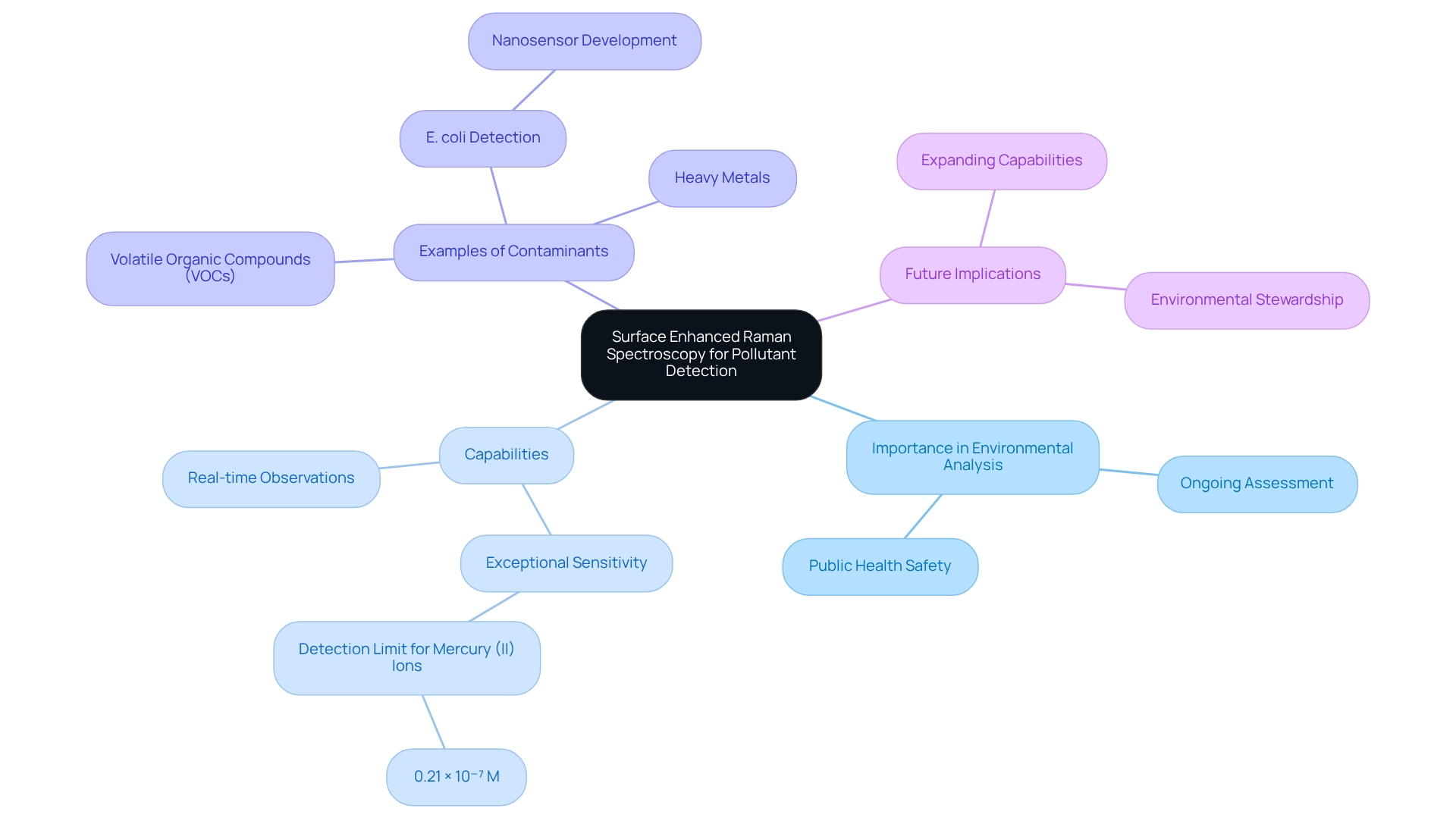
Pharmaceutical Applications: Enhancing Drug Development with Surface Enhanced Raman Spectroscopy
Surface enhanced raman spectroscopy is fundamentally transforming drug development within the pharmaceutical industry by facilitating rapid and precise analysis of drug formulations and their molecular interactions. This advanced technique enables the detailed characterization of drug compounds, effective monitoring of stability, and swift detection of impurities, which are critical for ensuring product integrity. By utilizing surface-enhanced Raman scattering, pharmaceutical firms can greatly optimize their research and development processes, leading to shorter time-to-market for new medications.
Recent advancements in surface enhanced raman spectroscopy technology have further improved its application in quality control, ensuring that pharmaceutical products consistently meet stringent regulatory standards. In 2025, the incorporation of this technology has led to a significant decrease in inter-trial intervals, which currently average 17 months, reduced from a high of 32 months during the pandemic. An executive at a large pharmaceutical firm remarked, "We’ll be ready to respond to any political shifts that happen in Washington, D.C., to ensure the consistency of our supply," emphasizing the significance of innovative methods such as surface enhanced raman spectroscopy in overcoming obstacles in drug development. This improvement underscores the efficiency gains achieved through the adoption of such analytical techniques.
Case studies demonstrate the strategic benefit of utilizing specific techniques in clinical data management, where efficient data processing directly affects cost efficiency, development timelines, regulatory success, and ultimately, patient outcomes. For example, the case study named 'Strategic Advantage of Clinical Data Management' illustrates how the system enhances data management processes, resulting in better regulatory compliance and quicker development cycles. As the pharmaceutical landscape continues to evolve, surface enhanced raman spectroscopy stands out as a crucial technology for improving drug formulation analysis and quality control, driving advancements in pharmaceutical research and development.
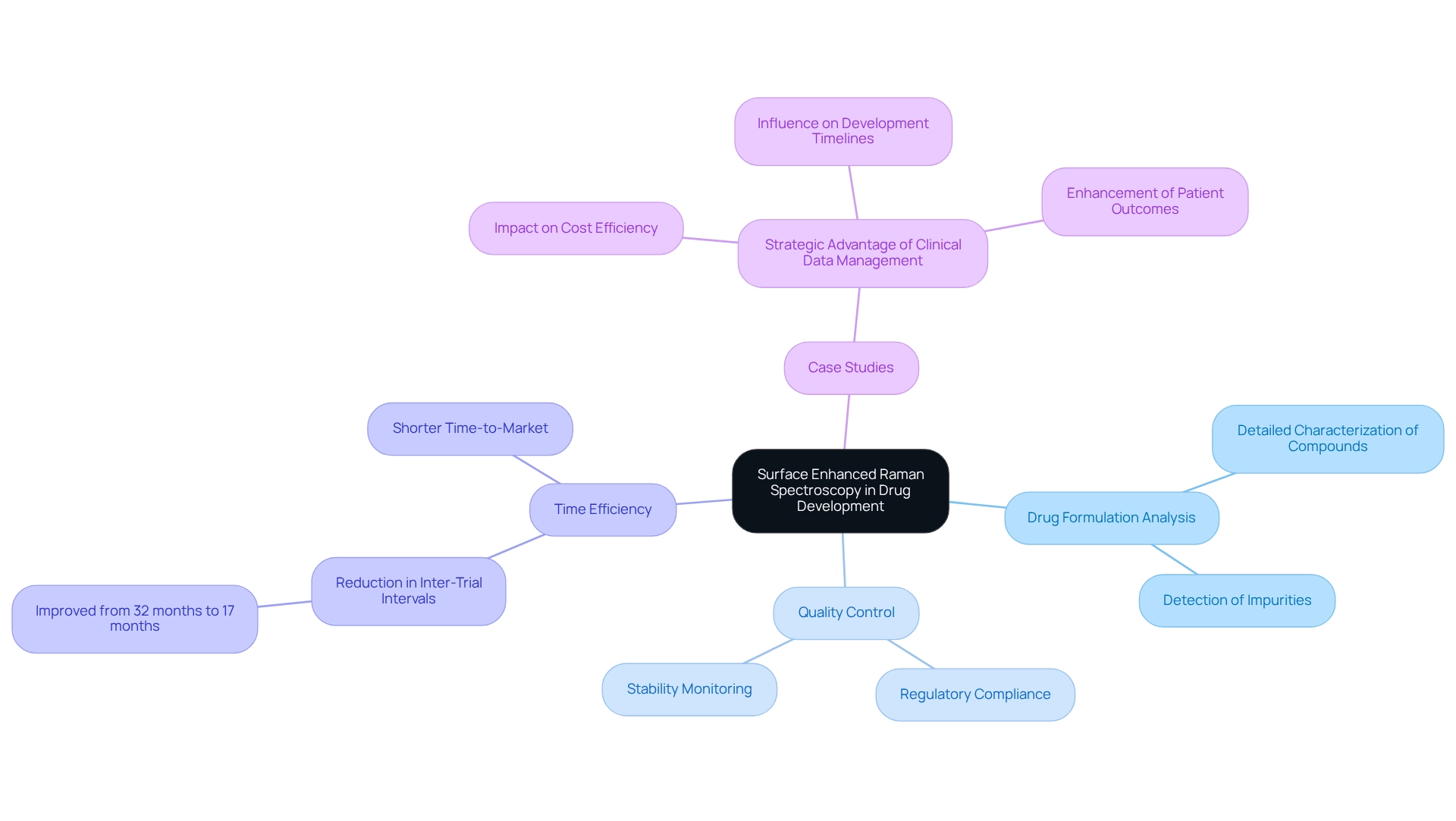
Cancer Diagnostics: Leveraging Surface Enhanced Raman Spectroscopy for Early Detection
Surface enhanced raman spectroscopy is revolutionizing cancer diagnostics, particularly in the early identification of various cancer types. By analyzing serum or tissue samples, surface enhanced raman spectroscopy (SERS) identifies distinct molecular signatures linked to cancerous cells, providing a non-invasive method that significantly enhances detection sensitivity. This capability not only aids in the early identification of cancer but also facilitates the monitoring of treatment responses, which is essential for personalized therapy, particularly through the effectiveness of surface enhanced Raman spectroscopy in clinical applications.
A notable study on nasopharyngeal cancer demonstrated that combining serum protein surface-enhanced Raman scattering with a partial least squares support vector machine (PLS-SVM) diagnostic algorithm achieved diagnostic accuracies of 95.09% in training sets and 90.67% in testing sets. Such impressive accuracy rates underscore the potential of surface enhanced raman spectroscopy (SERS) in distinguishing between healthy individuals and those diagnosed with cancer, as highlighted in its practical applications in various biomedical scenarios.
Surface enhanced raman spectroscopy is instrumental in detecting specific biomarkers that are indicative of early-stage cancer. This statement emphasizes the critical role of surface enhanced raman spectroscopy (SERS) in identifying cancer at its earliest stages. The impact of surface enhanced raman spectroscopy on cancer diagnostics is further illustrated by its function in tracking changes in cancer biomarkers during and after treatment, which is vital for tailoring therapies to meet individual patient needs.
As of 2025, the total US incidence rate for all cancer sites is projected to be 15.7 per 100,000, underscoring the urgent necessity for effective early identification methods, such as advanced technologies.
In conclusion, surface enhanced raman spectroscopy enhances the sensitivity of cancer identification and significantly improves the likelihood of successful treatment and patient survival, establishing it as an indispensable tool in modern oncology.
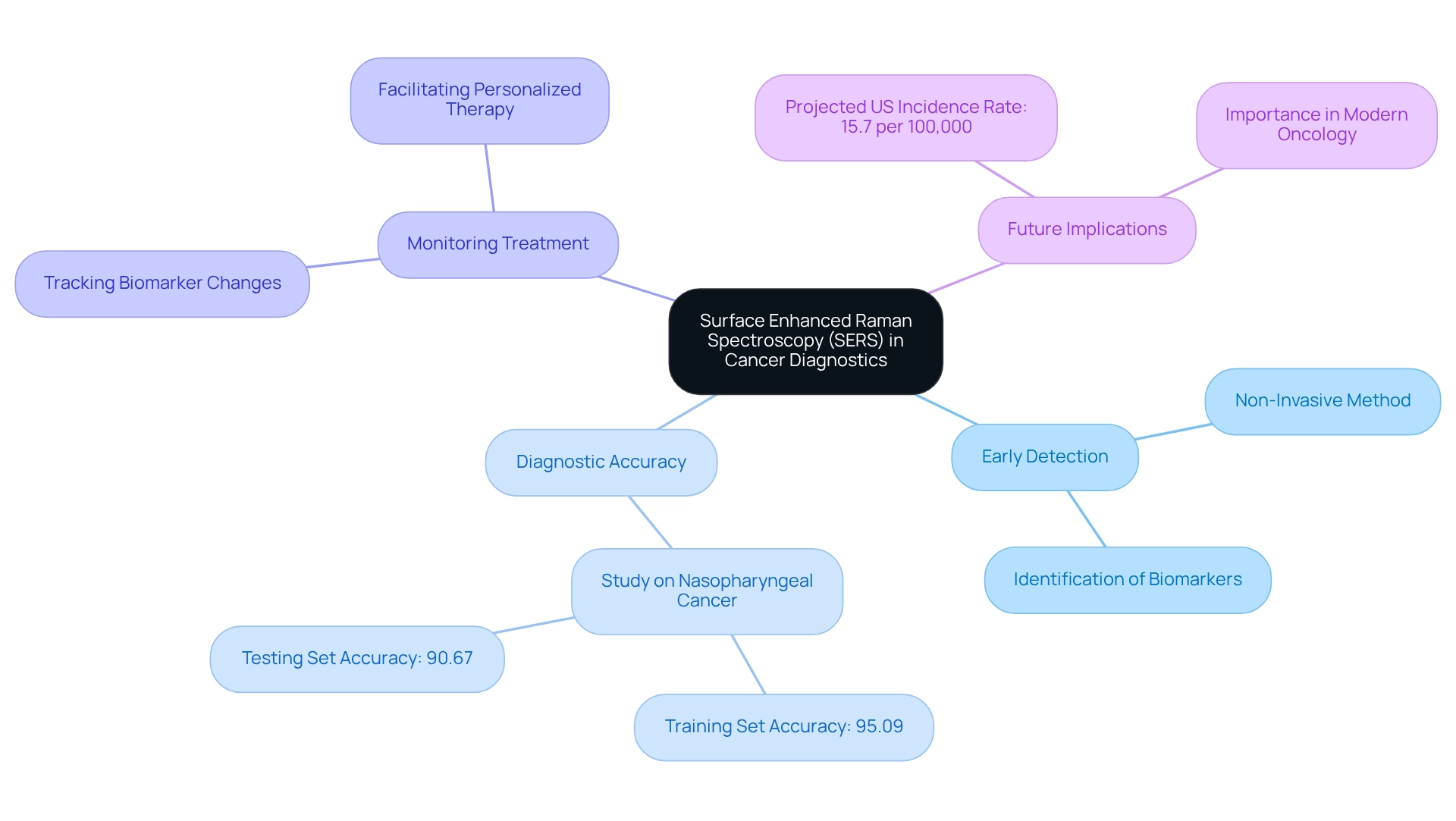
Biosensing Innovations: Surface Enhanced Raman Spectroscopy for DNA Mutation Detection
Surface Enhanced Raman Spectroscopy is revolutionizing biosensing applications, especially in identifying DNA mutations. This advanced technique facilitates the rapid and sensitive detection of genetic alterations that may indicate predispositions to diseases such as cancer. By employing surface enhanced raman spectroscopy (SERS)-based biosensors, researchers achieve remarkable specificity and sensitivity in mutation identification, which is crucial for enabling early diagnosis and personalized treatment strategies. The final step in this process assesses whether spectra pairs differ, indicating distinct oligonucleotides, a vital aspect of accurate mutation detection.
Recent advancements in surface enhanced raman spectroscopy technology have showcased its effectiveness in genetic diagnostics. For instance, studies demonstrate that these sensors can accurately differentiate between individuals who are COVID-positive and those who are COVID-negative, underscoring their potential for real-time health monitoring. Furthermore, the ability of surface enhanced raman spectroscopy to detect subtle spectral changes in biological samples allows for the identification of denaturation and conformational alterations in proteins. As noted by N. H. ul Huda, "The spectral changes indicate the denaturation and conformational shifts of proteins and fungal cell wall decomposition in complex exposed fungal samples," which is essential for understanding intricate biological processes.
In personalized medicine, surface enhanced raman spectroscopy is increasingly recognized for its role in the early detection of genetic disorders. The emergence of wearable sensors exemplifies this trend, enabling noninvasive examination of biofluids for continuous health monitoring. These sensors not only provide high sensitivity but also possess the capability to measure multiple analytes simultaneously, although challenges in fabrication and data analysis remain.
Expert opinions highlight the transformative potential of surface enhanced raman spectroscopy in biosensing applications for genetic testing. As the field progresses, the integration of surface enhanced raman spectroscopy technology into standard diagnostics is anticipated to enhance the accuracy of genetic evaluations, leading to more targeted treatment strategies and improved patient outcomes. This publication is licensed under CC-BY-NC-ND 4.0, permitting non-commercial sharing and redistribution of the article.

Clinical Diagnostics: Applying Surface Enhanced Raman Spectroscopy in Biological Sample Analysis
Surface enhanced raman spectroscopy is revolutionizing clinical diagnostics by enabling the examination of various biological samples, including blood, urine, and tissue. This advanced technique is particularly adept at detecting disease-associated biomarkers, providing critical insights that facilitate accurate diagnosis and effective treatment planning. Notably, surface enhanced raman spectroscopy exhibits exceptional sensitivity, allowing for the identification of low-abundance biomarkers essential for early disease detection.
For instance, the limit of detection (LOD) for mephedrone is approximately 1.6 μg/mL, showcasing the capability of surface enhanced raman spectroscopy to discern minute concentrations that conventional methods may overlook. Additionally, integrating surface enhanced raman spectroscopy into clinical workflows significantly enhances diagnostic precision, thereby improving patient management.
A compelling case study exemplifies this impact: the development of a SERS-integrated lateral flow assay for cardiac biomarkers has achieved ultra-sensitive detection, streamlining the diagnostic process and addressing the sensitivity limitations of traditional assays. Furthermore, the study's findings support the use of spectral analysis as a viable method for early cancer detection, underscoring its ability to identify critical biomarkers at initial stages.
As healthcare providers increasingly embrace surface enhanced raman spectroscopy, the potential for early intervention and improved patient outcomes becomes increasingly apparent, solidifying the technology's role as a transformative tool in clinical diagnostics. Yeonho Choi states, 'The remaining authors declare no competing interests,' emphasizing the integrity of the research related to surface-enhanced Raman scattering applications.
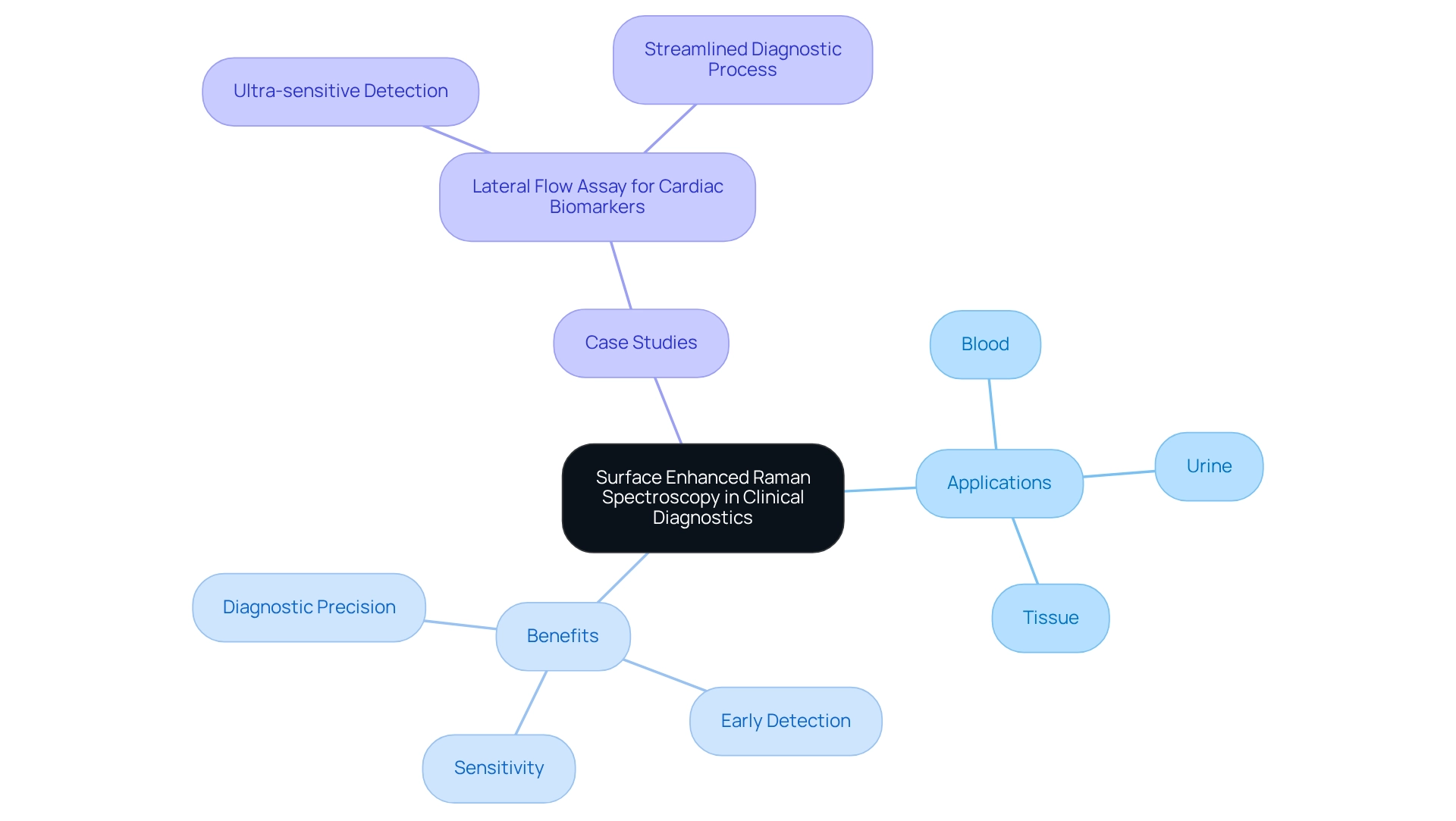
Data Analysis Advancements: Combining Surface Enhanced Raman Spectroscopy with Machine Learning
The integration of machine learning with surface enhanced raman spectroscopy is revolutionizing data analysis, particularly in the realms of molecular identification and quantification. By leveraging advanced algorithms, researchers can markedly enhance the interpretation of intricate surface-enhanced Raman scattering data, resulting in improved accuracy for diagnostics and monitoring applications. For example, recent studies have demonstrated that Raman spectra collected from several hundred points on a chip can yield approximately 1,000 data points each, creating a robust dataset for machine learning models to analyze.
This synergy not only streamlines the development of predictive models but also deepens the understanding of variable groups within spectral data. A notable case study employed pathway-guided random forest approaches to dissect predefined spectral groups, utilizing Learner of Functional Enrichment (LeFE) and prediction error (PE) methods. The findings underscored the importance of group membership in random forest analyses, illustrating how machine learning can elucidate complex relationships within spectral data.
Furthermore, the impact of artificial intelligence on molecular identification through surface enhanced raman spectroscopy is becoming increasingly apparent. As machine learning algorithms evolve, their efficacy in applications such as diagnostics continues to expand. By 2025, statistics project a significant rise in successful implementations of these algorithms across various scientific domains, particularly in healthcare and environmental monitoring. This trend underscores the potential of machine learning not only to enhance data analysis but also to drive advancements in these fields.
Experts assert that this combination represents a groundbreaking approach, with one specialist noting, 'S.S. did absolutely everything,' reflecting the profound influence of these innovations. This integration paves the way for future breakthroughs in analytical techniques, especially pertinent for pharmaceutical lab managers aiming to elevate their diagnostic capabilities.
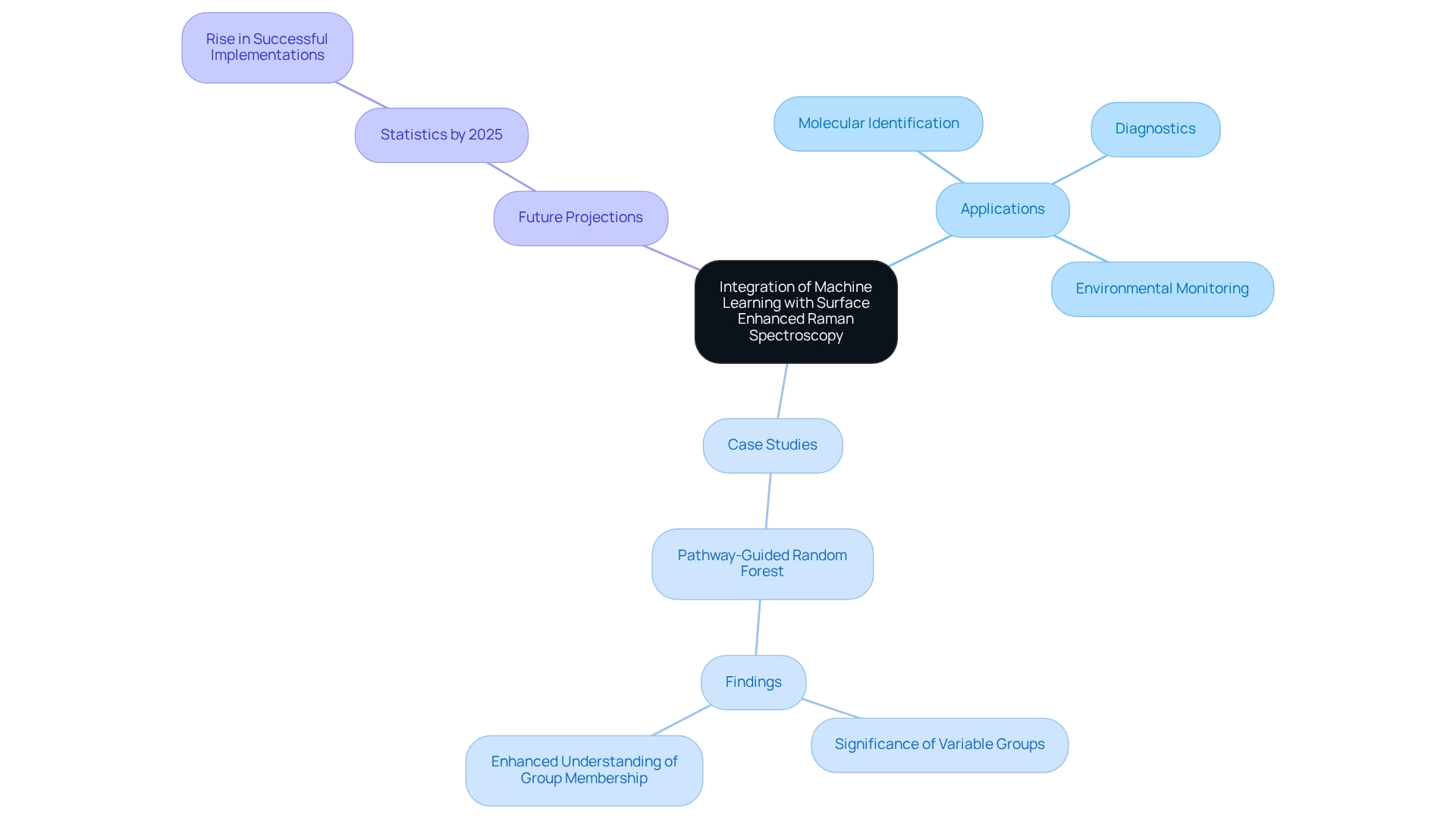
Nanotechnology Applications: Surface Enhanced Raman Spectroscopy in Nanosensor Development
Surface enhanced raman spectroscopy is revolutionizing the development of cutting-edge nanosensors by harnessing the unique properties of nanomaterials to significantly enhance the sensitivity and specificity of molecular identification. This integration empowers researchers to design sensors capable of detecting target analytes at remarkably low concentrations, even within complex matrices.
Recent advancements in surface enhanced raman spectroscopy have demonstrated sensitivity limits as low as 5 fM, showcasing a linear response across a concentration range of 1–100 fM, which is crucial for quantification in various applications. As Nam et al. note, 'Interestingly, for the same configuration but under resonance conditions, the lowest detectable particle concentration was 5 fM, which represents an improvement of 2 orders of magnitude in the threshold, additionally showing a linear dependence over 1–100 fM range, which makes them suitable for quantification purposes.'
The implications of these advancements are profound, particularly in fields such as environmental monitoring, food safety, and medical diagnostics, where rapid and accurate identification is essential. In medical diagnostics, surface enhanced raman spectroscopy (SERS)-enabled nanosensors are being developed to detect biomarkers associated with diseases at early stages, thereby enhancing the potential for timely interventions.
A notable case study illustrates the development of Two-Photon Excited Surface-Enhanced Hyper Raman Scattering (SEHRS), which merges two-photon excitation with plasmonic enhancement, resulting in substantial improvements in signal identification and facilitating detailed characterization of molecular interactions at the nanoscale.
Key players in the surface-enhanced Raman substrate market, including EnSpectr, Hamamatsu Photonics K.K., and HORIBA, Ltd., are actively contributing to the progress of this technology, further underscoring its significance in the industry. As the field evolves, the demand for reliable quantification techniques becomes increasingly critical, paving the way for broader applications in both industrial and clinical settings.
The ongoing research and development in nanotechnology applications of surface enhanced raman spectroscopy are poised to further elevate the sensitivity and specificity of molecular detection, ultimately advancing healthcare and environmental safety.
Future Prospects: The Evolving Role of Surface Enhanced Raman Spectroscopy in Science
The future of surface enhanced raman spectroscopy (SERS) is exceptionally bright, propelled by ongoing research and technological innovations that are set to expand its applications across various scientific fields. As investigations into new nanomaterials advance, improvements in surface-enhanced Raman scattering methods are anticipated to significantly enhance both sensitivity and specificity. Notably, the integration of surface enhanced raman spectroscopy with complementary analytical techniques, such as mass spectrometry and chromatography, is expected to establish more robust analytical frameworks, thereby improving the precision of results in critical areas like biomedicine, environmental monitoring, and food safety.
In 2023, the biosensors segment is projected to lead the substrate market, representing over 40% of the total market share, reflecting the growing need for sensitive identification techniques. Furthermore, the global market for surface enhanced raman spectroscopy is expected to experience a compound annual growth rate (CAGR) of 7.7% from 2025 to 2032, underscoring the increasing relevance of SERS in scientific research. This market is anticipated to grow significantly, with a projected revenue of USD 49.5 billion by 2032, driven by the escalating demand for sensitive detection methods across multiple industries.
However, challenges persist. As Vipul Patil, a management consultant, observes, "High cost of systems, presence of substitute technologies like IR spectroscopy, and requirement of skilled personnel are key factors hampering market growth." Technological advancements, including the application of artificial intelligence for data analysis, will further enhance the utility of surface enhanced raman spectroscopy, enabling researchers to extract insights from complex datasets more efficiently. Real-world examples of surface enhanced raman spectroscopy integration with other techniques underscore its versatility; for instance, combining it with imaging techniques has shown promise in enhancing diagnostic capabilities in medical applications.
As the landscape of scientific research evolves, the role of surface enhanced raman spectroscopy (SERS) is set to significantly contribute to advancements in diagnostics, monitoring, and innovative research methodologies, paving the way for breakthroughs across multiple industries.
Conclusion
The transformative potential of Surface Enhanced Raman Spectroscopy (SERS) is evident across various critical fields, including healthcare, food safety, environmental monitoring, and pharmaceuticals. By enhancing the sensitivity and specificity of molecular detection, SERS enables the early diagnosis of diseases, ensures food quality, and facilitates real-time pollutant detection, thereby safeguarding public health and improving patient outcomes.
As SERS integrates with advancements in nanotechnology and machine learning, its applications are poised to expand even further. From revolutionizing remote patient monitoring with electronic stethoscopes to enhancing drug development processes, the impact of SERS is profound and far-reaching. The promising growth of the SERS market and its adoption in clinical settings underscore its significance in modern diagnostics and monitoring strategies.
In conclusion, the future of SERS is bright, with ongoing research and technological innovations paving the way for new applications and improved methodologies. As industries increasingly recognize the value of sensitive detection methods, SERS is positioned to play a pivotal role in advancing scientific progress and ensuring a healthier, safer world. The commitment to harnessing this technology will undoubtedly lead to breakthroughs that enhance not only individual health outcomes but also the overall quality of life in society.

